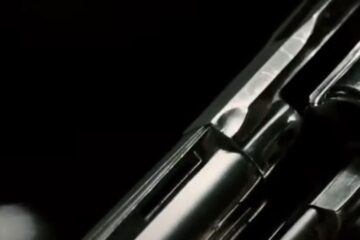An Ode to the 7.62x39mm (M43) Soviet
“I never shall forget it whilst I remember anything,” wrote abolitionist, freedman, and author Frederick Douglass in his book entitled Narrative of the Life of Frederick Douglass, an American Slave, Written by Himself. While Douglass employs the line in recalling barbarousness committed against his aunt, the line is relevant wherever an indelible memory is made.
For me, that line harkens back to a blustery December evening, when a young teenage boy—and novice big-game hunter—was surveilling a shallow, brush-choked dell. Shortly after arriving at my destination, a duo of does entered the entangling flora and cautiously began their decent to the wide creek bottom below. Once the lead, and larger, doe entered one of the few natural openings, I whistled to halt her progress, took aim, and, after exhaling, proceeded to send an odd-sized bullet downrange. The doe hit the ground before I recovered from the recoil. It was my first whitetail deer, though it wouldn’t be the last for that economical, surplus Chinese SKS rifle that my father purchased from Roses for little more than $100.
Decades of owning, testing and fielding innumerable rifles and chamberings has taught me many lessons. One of them is that, although 7.62x39mm (M43) Soviet lacks the prestige of many “hunting” cartridges, the underrated and underutilized round is an effective game-getter at practical ranges. Given its origins, that is hardly surprising.
- Activate Your Own Stem Cells & Reverse The Aging Process - Choose "Select & Save" OR Join, Brand Partner & Select Silver To Get Wholesale Prices
- Get your Vitamin B17 & Get 10% Off With Promo Code TIM
- How To Protect Yourself From 5G, EMF & RF Radiation
- Protect Your Income & Retirement Assets With Gold & Silver
- Grab This Bucket Of Heirloom Seeds & Get Free Shipping With Promo Code TIM
- Here’s A Way You Can Stockpile Food For The Future
- Stockpile Your Ammo & Save $15 On Your First Order
- Preparing Also Means Detoxifying – Here’s One Simple Way To Detoxify

Origins and Specifications
Like so many of our great sporting cartridges, the 7.62x39mm created for the battlefields. According to Frank C. Barnes in Cartridges of the World, 13th Ed., “This cartridge was adopted as the result of Russian military experience against German assault rifles chambered for the 7.92mm Kurz.” In this case, “experience” refers to the Red Army incurring the wrath of the 7.92 Kurz—as it’s also known—at the Battle of Cholm.
It’s often said that “necessity is mother of invention.” Well, the Russians, like the Germans, discovered that they needed an intermediate-range cartridge; effectively, it would offer superior external and terminal ballistics to those produced by a pistol or submachine gun, as well as improved portability and less recoil than generated by the Red Army standard rifle cartridge, the 7.62x54mm R. The latter aids controllability in full-automatic firing. It is also why the cartridge is a good option for novice and recoil-shy hunters.

When developing the cartridge, the Russians required it reliably function in semi-automatic and full-automatic rifles, including machineguns. “Original use was in the SKS semi-automatic carbine, later replaced by the AK-47 selective fire assault rifle,” wrote Barnes. “The RPD light machine gun also uses the M43 cartridge.” Outside of modern sporting rifles (MSRs) and a few of bolt-actions, the cartridge is most encountered in AK-47 and SKS rifles.
The first iteration of the round, which was dubbed the 7.62x41mm due to its case length, was adopted in 1943. In subsequent years the cartridge was refined to what we now know as the 7.62x39mm (M43). Produced from 1944 on, it wouldn’t see widespread use until after World War II; however, since that time, it has been used worldwide by those fighting for freedom—and against it.

The 7.62x39mm was originally loaded with 123-grain bullets with an elaborate configuration; a steel core was surrounded by lead, and that was contained within a copper-coated steel jacket. A variety of bullet-making materials, profiles, dimensions, and techniques, including heat treatment, were tested through the years. Note that the cartridge generally employs a 0.311-inch to 0.312-inch-diameter bullet, with 0.311 inches being most common. At times, 0.310-inch can be found, too. The Sporting Arms and Ammunition Manufacturers’ Institute (SAAMI) set the maximum average pressure (MAP) at 45,000 psi, though that for the Commisson Internationale Permanente Pour L’epreuve Des Armes A Feu Portatives (CIP) is higher.
As for the beltless, rimless, bottleneck case, it has significant taper and a shallow shoulder angle to improve reliable feeding and extraction across a range of rifles. It’s also more essential since steel, rather than brass, was first used as the case material. It tapers from 0.443 inches forward of the extraction groove to 0.396 inches at the shoulder. That taper leads to the trademark banana shape of the magazine present on AK-47-type rifles. Case capacity is around 35 grains.

Ballistics
When compared to many traditional “hunting” cartridges, the ballistics for the 7.62x39mm are unimpressive, to say the least. That’s not surprising, though, since it was designed for the targeting of enemy combatants out to intermediate ranges. This isn’t helped by the short, lightweight and low-ballistic-coefficient (BC) bullets mandated by the smallish case. As an example, when using a 123-grain bullet—in this case, a Hornady FMJ with a .266 G1 BC—at 2350 fps, such as noted by SAAMI, the projectile will strike 3.94-inches low at 200 yards and 20.76 inches low at 300 when a 150-yard zero is used. Energy levels are 844 ft.-lbs. and 619 ft.-lbs., respectively. By switching to a more streamlined bullet, such as Hornady’s 123-grain SST, which has a G1 BC of .295, you’ll get a somewhat flatter trajectory. But no projectile will turn it into something that it’s not, and that is a long-range performer.
Those with a captivation in cartridges—count me among them—generally like to compare them. It’s fair to do so here as well. Generally, the layman ballistician compares the 7.62x39mm to the antiquated, yet effective, .30-30 Winchester. How does it stack up? With a Hornady 150-grain Round Nose InterLock bullet propelled to 2390 fps, it’ll drop 4.4-inches at 200 yards and 24.64 inches at 300 yards when a 150-yard zero is used. Energies at those distances are 834 ft.-lbs and 542 ft.-lbs. Even the LeveRevolution load with the 160-grain FTX (.330 G1 BC) only slightly betters it, posting a 3.45-inch drop at 200 and 17.84-inch drop at 300. It will maintain more than 1,000 ft.-lbs. of energy at 300 yards.

The 7.62x39mm can also be compared fairly to the newer .300 Blackout. For instance, when zeroed at 150 yards, the 135-grain FTX from the .300 AAC Blackout will impact 5.17 inches low at 200 yards and 26.91 inches at 300 yards, where it still has 725 ft.-lbs. and 537 ft.-lbs. energy, respectively.
How the 7.62x39mm, .300 AAC Blackout and .30-30 Winchester “stack up” depends on the loads selected; however, it’s fair to say that the three are, ballistically speaking, nearly identical, and thus suitable for the same species. The stately .30-30 Win. has been used on all matter of game since it debuted in 1895; however, it’s true forte is deer-sized game out to 200 yards or so, and larger or more dangerous critters, such as black bear and feral hogs up close. Can it be used on elk? Absolutely, and so can the 7.62x39mm provided that a quality bullet is properly placed. But that is not its strength, and such is evident in the available ammunition.

Ammunition & Arms
Ammunition for the 7.62x39mm is a catch-22. On one hand, most imported loads are, by centerfire standards, quite affordable—even in these volatile times. But many of those options feature bullets with copper-washed-steel jackets, which can hasten erosion of the rifling. Most are FMJs as well. There are some soft-point and hollow-point configurations that work well for deer-sized game and feral hogs; I know because I exclusively used them for years. Usually found in 122- to 123-grain weights, they can be had from Wolf and TulAmmo, These are non-corrosive; however, be leery of old military loads, as they frequently used corrosive primers. Brass loads are fewer in number and pricier but easy on your rifle. The bullets are better suited for hunting as well.

For those who want brass-cased loads with cup-and-core-style, soft-point and hollow-point bullets, they are available from Federal, Hornady, PPU and Sellier & Bellot, while premium, lead-core offerings are made by Hornady, Nosler, Winchester and Remington. Standout projectiles for hunting include: 123-grain SST (Hornady); 123-grain Extreme Point (Winchester); and Ballistic Tip (Nosler). Those desiring or needing a lead-free option will find it in Nosler’s 123-grain E-Tip and Underwood’s 123-grain Lehigh Defense Controlled Chaos ammunition. The former would, arguably, be the best choice for someone pursing elk or moose with their 7.62x39mm-chambered rifle. Varmint and predator hunters have a good option in Nosler’s Varmageddon 123-grain polymer tip, flat-base load.

As is always the case, handloading can increase your access to ammunition—especially that featuring quality projectiles. Besides most of the previously mentioned projectiles, handloading provides enables the use of the following projectiles: Hornady 123-grain Spire Point; Barnes 123-grain TSX; Barnes Multi-Purpose Green 108-grain HP; Sierra Pro-Hunter 125-grain spitzer; and Speer Gold Dot 123-grain bonded soft point, among others. You’ll also be able to load bullets in the 150-grain range, though reduced velocity can compromise expansion.

When selecting a bullet, it pays to find one that matches the diameter of your bore. While American-made rifles are consistent from rifle to rifle in their bore diameter, such is not the case with foreign military rifles. By choosing one that matches your rifle (i.e., 0.311-inch, 0.311 inches) you’ll waste less time and money trying to find an accurate combination.
The limiting factor to handloading the 7.62x39mm is the brass. As most foreign fodder uses Berdan-primed steel cases, and semi-automatic rifles can damage and “send yonder” your fired ones, one might question the practice. It is worth the hassle. Besides once-fired brass, component brass is offered by Lapua, Starline, Hornady, and Nosler—when available. I use Lapua. It currently runs about $0.90 each, and it stands up to countless loading-and-firing cycles. It’s also very consistent, which helps improve accuracy. Will you see a huge change in a surplus SKS or AK? No, but you will elsewhere.
Inspect your brass (especially if it’s hand-me-downs), as in the past the cartridge has, at times, featured small rifle primers, though this is rare. Standard large rifle primers are ideal nowadays. If you’re using an SKS, be sure that the firing pin channel is clean to prevent slam-fires, which it’s been known to do because of the floating firing pin.

As for powder, some of the best choices for the 7.62x39mm are: Vihtavuori N110, N120, and N130; Hodgdon Benchmark, H335, BLC-2 and CFE BLK; IMR 4227 and 4198; Alliant Reloder 7 and 1200-R; Accurate 1680, 5744, LT-30 and LT-32; and Ramshot X-Terminator. Die sets for the chambering generally come with everything needed to load 0.308-inch and 0.311-inch-diameter bullets.

It’s preferable to purchase a new rifle in 7.62x39mm for hunting over a military rifle—even the SKS. Sure, it worked for me, but the accuracy it attained could never match what a well-made rifle can. Hunters desiring a bolt-action rifle will find it in the CZ 527 American, Ruger American Ranch and Howa Mini Action Rifle. Best of all, because of the cartridge’s 2.200-inch maximum cartridge overall length (COL), these rifles have shorter overall lengths and lighter weights. MSRs and pistols with the chambering are available from Rock River Arms (LAR-47 series), CMMG (Resolute and Banshee 300, 200 and 100) and Windham Weaponry (7.62x39mm and SRC variant). Additionally, AR-Stoner has an upper with a 16-inch barrel in 7.62x39mm. AK-47s were omitted due the inconsistency (accuracy wise) across them. Whatever model you choose, ensure that the magazine capacity is legal for hunting at your destination, and if you’re going secondhand, confirm the diameter of the bore.

Though that original 7.62x39mm SKS was—sadly—sold long ago, I haven’t been without a rifle in the chambering for long. For most of the hunting that I do in Virginia, the cartridge will handle what I ask of it. If you try it, you will reach the same conclusion that I did. It’s the perfect cartridge for bringing home the bacon … or venison. Indeed, “I never shall forget it whilst I remember anything.”
Article by Aaron Carter














